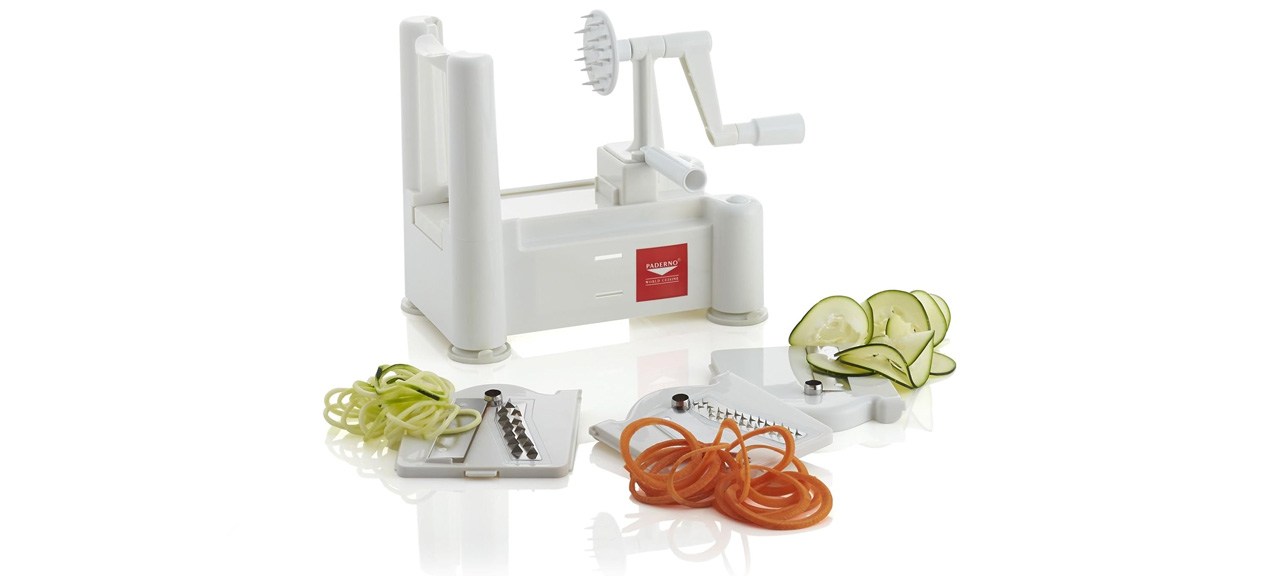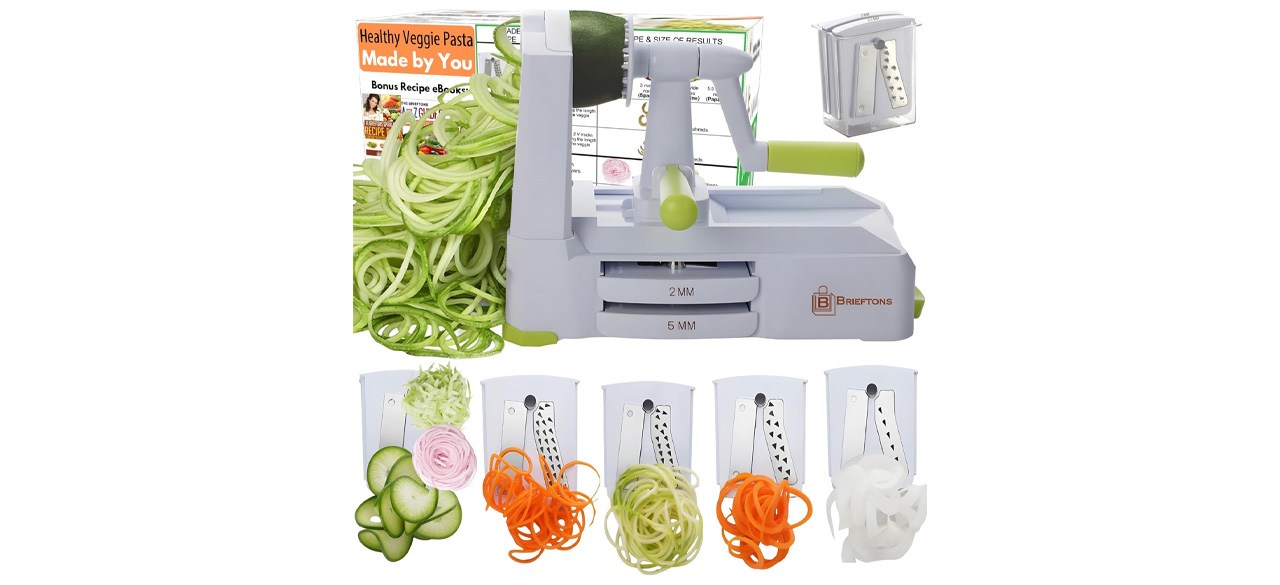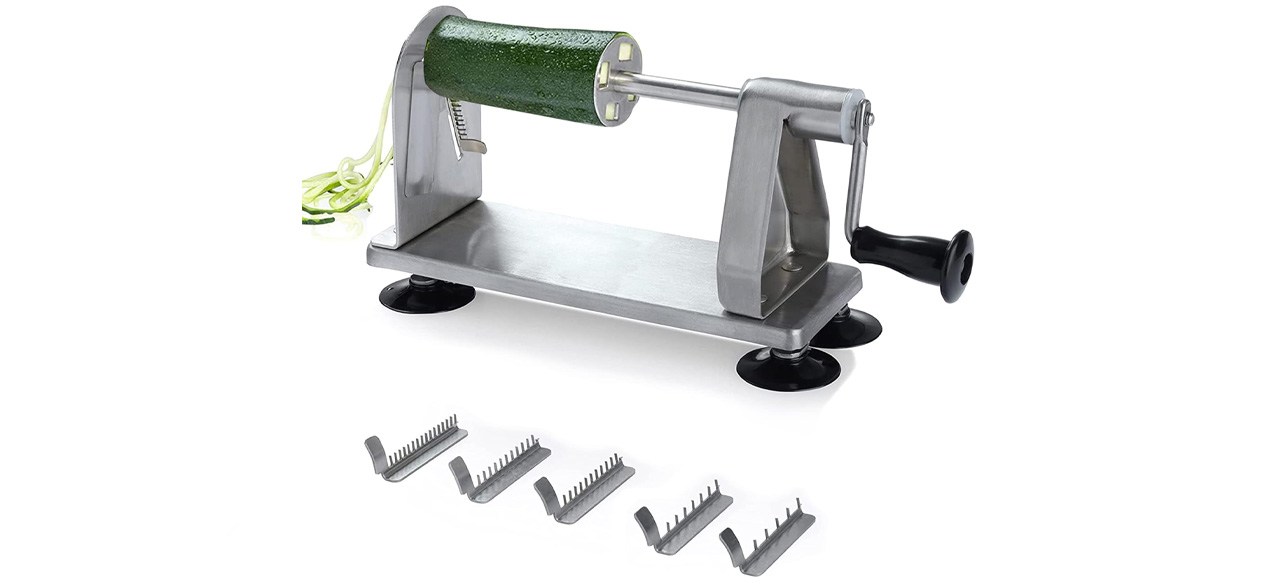Which spiral slicer is best?
There is little doubt that noodle and pasta dishes are extremely popular, but there are some dietary challenges when it comes to flour-based pasta. It is dense with carbohydrates, and it may also contain high levels of gluten. One healthy alternative to traditional pasta has become increasingly popular in recent years: vegetable-based “pasta” ribbons.
Creating these guilt-free, gluten-free noodles involves the use of a special kitchen gadget known as a spiral slicer, or spiralizer. The user places vegetables such as zucchini, cucumber, or squash into the spiral slicer, and special blades trim it into flat ribbons of varying sizes. These ribbons can be steamed, boiled, or even served raw with an appropriate sauce. It is possible to duplicate such popular dishes as lasagna, spaghetti or ramen without worrying about gluten sensitivity or the effects of dense carbohydrates on blood sugar.
There are essentially two types of spiral slicers on the market today: crank-style and handheld. Our favorite from Paderno is a crank-style slicer that creates ribbons for a healthy alternative to pasta.
What to know before you buy a spiral slicer
There are several important elements to consider when shopping for a spiral slicer.
Ease of use
Many shoppers find that a crank-style spiralizer mounted on a secure base is easier to use than a handheld model with no support. Each model poses challenges, but creating a long, unbroken strand or ribbon can involve a learning curve, especially with a handheld model. It is helpful to find a model where mounting the vegetable or fruit is intuitive and only requires minimal prep work.
Cleaning and maintenance
Some spiral slicers may contain five or more extremely sharp blades, which need to be carefully cleaned and stored between uses. Handheld models should include protective covers, and crank-style models should have a good onboard blade storage system.
Size
Handheld spiralizers can usually handle fruits and vegetables of any size due to an open-ended design, but crank-style models may have some size limitations. Some can handle 10-inch long cucumbers or zucchini, while others require users to trim the produce down before processing.
What to look for in a quality spiral slicer
Blade options
Most spiral slicers offer a choice between thin strands for noodle dishes and thicker ribbons for pasta and lasagnas. However, the better models also offer blades for more specialized slices, such as a continuous ribbon or stylized garnish.
Suction cup stabilizers
While handheld spiral slicers do not include any stabilizers, crank-style models usually feature a suction cup system that keeps the unit securely attached to the table or cutting board. This can be a very important safety feature, especially when working with larger batches.
How much you can expect to spend on a spiral slicer
Most handheld spiral slicers hover around $10-$15; these are generally limited to two-blade options. Crank-style spiralizers with multiple blade options can run as much as $30 to $35, but they do not require as much of a learning curve as basic handheld models.
Spiral slicer FAQ
Are there recipes available for spiralized fruits and vegetables?
A. Many spiral slicing systems include a basic recipe book containing common dishes you can make with spiralized foods. Many home cooks use ribbon or flat-cut vegetables as substitutes for wheat-based pasta if gluten is an issue. Spiralized fruits and vegetables also work well in cold salads and as garnishes.
Are spiral slicers safe for my older children to use?
A. The blades of a spiral slicer can be extremely sharp, and at least part of the blade is exposed during normal operation. However, an adult can set up the machine, attach the blade, and position the food before allowing an older child to turn the crank and produce the ribbons. We would not recommend allowing a child to clean the machine, however.
Which type of spiral slicer is best for a beginner?
A. Handheld spiral slicers may be more affordable than crank-style models, but we recommend a sturdier crank-style slicer for inexperienced cooks. Using a handheld spiral slicer requires more of a learning curve, and the results may not be as consistent as those created by a crank-style model.
What’s the best spiral slicer to buy?
Top spiral slicer
Paderno World Cuisine 3-Blade Vegetable Slicer/Spiralizer
What you need to know: The Paderno World Cuisine slicer/spiralizer is comparable in performance to models twice its price. It’s a good all-around choice for experienced home cooks.
What you’ll love: It has extremely sharp stainless steel blades and a straightforward, intuitive operation. Minimal prep work is required and it is dishwasher safe.
What you should consider: Minimal instructions are included. Creating long, unbroken strands requires practice.
Top spiral slicer for money
Brieftons 5-Blade Vegetable Spiralizer
What you need to know: This five-blade spiralizer suctions strongly to countertops.
What you’ll love: It’s sturdy and comes apart for easy storage. It comes with a recipe book and a storage container for the blades. You can release the blades quickly with just the push of a button.
What you should consider: It’s difficult to clean.
Worth checking out
Homarden Stainless Steel Vegetable Spiralizer
What you need to know: This straightforward spiralizer is simple to use and easy to store.
What you’ll love: It has sharp blades and grips well to a counter with its rubber feet. It can create different sizes of spirals, from 2 to 6 millimeters.
What you should consider: It creates a lot of food waste, according to some users.
Prices listed reflect time and date of publication and are subject to change.
Check out our Daily Deals for the best products at the best prices and sign up here to receive the BestReviews weekly newsletter full of shopping inspo and sales.
BestReviews spends thousands of hours researching, analyzing and testing products to recommend the best picks for most consumers. BestReviews and its newspaper partners may earn a commission if you purchase a product through one of our links.










